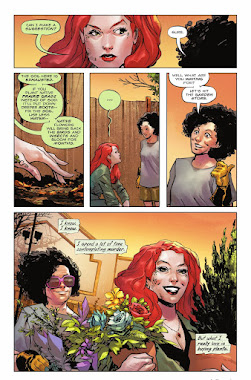Letters: Hassan Otsmane-Elhaou
Cover: Jessica Fong
Variant Covers: Stanley “Artgerm” Lau & Joshua Middleton; Justine Frany; Seb McKinnon; Joëlle Jones with Jordie Bellaire
Publisher: DC Comics
Price: 3.99
Release Date: August 3rd, 2022
Hope and Faith
(Very minor spoilers follow.)
The titular character in Poison Ivy has been remorseless and somewhat brutal so far. She is perfectly capable of killing even people that she makes a connection with (as seen in Poison Ivy #2). But finally, in Poison Ivy #3, the human cost catches up to her. As dedicated as she is to her goal of ecological rejuvenation by any means necessary, she can’t ignore what she’s doing to make it happen.
Poison Ivy #3 is another character vignette. The thought and detail that G. Willow Wilson put into her depiction of Ivy has been obvious since the first issue, and the previous issues were heavily character focused and concerned more with the small, individual stories than the larger plot. Poison Ivy #3 keeps that going. Wilson crafts a small story putting Ivy together with a hotel manager who wants to rehabilitate a garden on the property, and Ivy spends the whole issue reflecting on what that means for her cause. This a fascinating story after the previous issue, but Poison Ivy #3 does feel a little forced, but it does mostly work as a setup for an unexpected look at what Ivy is thinking.
The themes at the heart of Poison Ivy #3 are hope and faith. Ivy is long since hopeless, resigned to the fact that no matter how hard she tries she’ll never complete her work. Even a rejuvenating act as wholesome as planting a tree is poisoned by this hopelessness. Why help nurture life when she’s destroying so much of it? “Why?” is an existential question that we all ask ourselves at some point. And it’s faith–faith in life–that gives her her answer. This isn’t to suggest that Wilson is suddenly rehabilitating Ivy. She’s not. Ivy is no less committed to her purpose at the end of Poison Ivy #3 than she was before. But Wilson successfully makes Ivy a character we want to pull for despite what she’s done. Her motives were always understandable even if her actions were horrific. It’s not true to say she’s sympathetic at this point. Ivy remains unrepentant and no less committed to her goal–but Wilson gives us the thing that Ivy doesn’t have: hope. Hope for her.
With this heavy focus on hope and faith, it’s also worth visiting a brief moment that happens right at the start of Poison Ivy #3. Ivy ponders the possibility that she won’t live to see the world she’s creating. This idea has a basis in myth (the one I immediately keyed in on was Moses not entering the promised land he led the Israelites to). It calls to mind the notion that the agent of positive change has to bear the price for it–perhaps going so far as to say they don’t deserve it thanks to whatever actions they might have taken along the way.
Happiness
It’s strange to see so much life in Poison Ivy #3. Marcio Takara and Arif Prianto were so effective at depicting fungus and death in the first two issues of Poison Ivy that this issue’s non-stop bright, energetic look comes somewhat out of nowhere. It’s most welcome, though. It fits completely with the inner conflict Wilson wrote for Ivy that ultimately leads her, in this case, to embracing the life that she’s trying to make flourish. There are several pages where Ivy is so happy it’s infectious. While Willow’s script likely described Ivy’s overall emotions in this moment, Takara’s art makes it absolutely radiate and delivers an emotional high we haven’t seen to this point.
There is something to nit pick here. It’s somewhat unbelievable that the two women could clean this garden area in one day. Among the garbage strewn in it is a rusted out truck with no tires and weeds growing out of its engine. I don’t know how much of the detail of the garden’s original state was dictated by Willow and how much was created by Takara, but it makes what is essentially a montage sequence of yard work feel a little silly. That said, it’s a very minor complaint and there is a good narrative reason for Ivy to not stick around beyond a single day of work.
Final Thoughts
Whether you like Ivy’s return to villainy, it’s inarguable that Wilson did a deep dive into the character. This might be most evident in Poison Ivy #3. Ivy was single minded in the previous two issues. After killing a diner full of people who she seemed to make human connections with, there’s a sense that her humanity is subsumed to an extent and that no one is safe–that was certainly my assumption going into this issue. But with Poison Ivy #3 Wilson upends some of those expectations and makes Ivy even more complex.






.png)
No comments:
Post a Comment